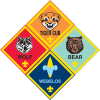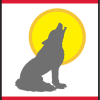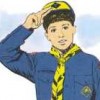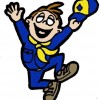Belt Loop
Complete these three requirements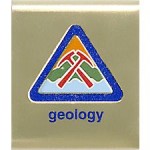
- Explain to your den or an adult family member what geology means.
- Collect samples of igneous, sedimentary, and metamorphic rocks. Explain how each was formed.
- Collect samples of three minerals. Explain to your family or den what a mineral is and show and tell about the minerals you collected.Tell a story or relate an incident to a group of people, such as your family, den, or members of your class.
Academics Pin
Earn the Geology belt loop and complete five of the following requirements.
- Make a plaster cast of a fossil.
- Make a special collection of rocks and minerals that illustrates the hardness scale.
- Give examples of sedimentary, igneous, and metamorphic rocks.
- Gather several different types of rocks. Compare them and put them in groups according to physical properties such as color, texture, luster, hardness, or crystals.
- Describe the effects of wind, water, and ice on the landscape.
- Make “pet rocks” using rocks, paint, and glue-on eyes. Tell a creative story about your pet rocks.
- Draw a diagram showing different types of volcanoes or draw a diagram that labels the different parts of a volcano.
- Make a crystal garden.
- Make a collection of five different fossils and identify them to the best of your ability.
- Make a poster or display showing 10 everyday products that contain or use rocks or minerals.
- Visit a mine, oil or gas field, gravel pit, stone quarry, or similar area of special interest related to geology.
- With your parent or adult partner, visit with a geologist. Find out how he or she prepared for the position. Discuss other careers related to geology.
- Draw the inside of a cave showing the difference between stalactites and stalagmites
Additional Information
Mohs Hardness Scale
Hardness is identified numerically by comparison to standard minerals on the Mohs Scale,from 1 (softest) to 10 (hardest):
2. Gypsum
3. Calcite
4. Fluorite
5. Apatite
7. Quartz
8. Topaz
9. Corundum
10. Diamond
A mineral of a given hardness will scratch a mineral of a lower number. With a systematic approach, you can use minerals of known hardness to determine the relative hardness of any other mineral. There are a few handy objects that also fit in this scale. A fingernail is 2.5, a penny is 3, a knife blade is 5.5, glass is 5.5, and a steel file is 6.5.
Three Kinds of Rocks
Sedimentary Rocks (Sandstone, Limestone, Shale, Gypsum)
For thousands, even millions of years, little pieces of our Earth have been eroded—broken down and worn away by wind and water. These little bits of earth are washed downstream, where they settle to the bottom of the rivers, lakes, and oceans. Layer after layer of eroded earth is deposited on top of each. These layers are pressed down more and more through time, until the bottom layers slowly turn into rock.
Igneous Rocks (Granite, Basalt, Pumice, Obsidian)
Igneous rocks are called fire rocks and are formed either underground or above ground. Underground, they are formed when the melted rock, called magma, deep within the earth becomes trapped in small pockets. As these pockets of magma cool slowly underground, the magma becomes igneous rocks. Igneous rocks are also formed when volcanoes erupt, causing the magma to rise above the earth’s surface. When magma appears above the earth, it is called lava. Igneous rocks are formed as the lava cools above ground.
Metamorphic Rocks (Marble, Schist, Gneiss, Slate)
Metamorphic rocks are rocks that have “morphed” into another kind of rock. These rocks were once igneous or sedimentary rocks. How do sedimentary and igneous rocks change? The rocks are under tons and tons of pressure, which fosters heat build-up, and this causes them to soften and change.
Items Made From Rocks and Minerals
Some everyday items that are made from or consist of rocks or minerals include jewelry, table salt, chalk, pencil lead, coins, wire, cans, safety pins, scissors, chewing gum wrappers, roads, and glass. There are many, many others.
Crystal Garden
6 tablespoons of water
1 tablespoon of ammonia
6 tablespoons of laundry bluing
6 teaspoons of salt
6 pieces of charcoal—the kind used for outdoor cooking
Mix the water, ammonia, bluing, and salt in a bowl. Put the charcoal in a pie pan. Pour the liquid over the pieces of charcoal. Put the pie pan in a warm place where the water will evaporate quickly. When the water has evaporated, a “garden” of crystals will have grown!
Resources
Check the children’s section at your local library for information on geology. If you have access to the Internet, try using various search engines to look for the information you need. (Be sure you have your parent’s or adult partner’s permission first.)
A field trip to a museum can provide an excellent hands-on experience with rocks and minerals in your local community

